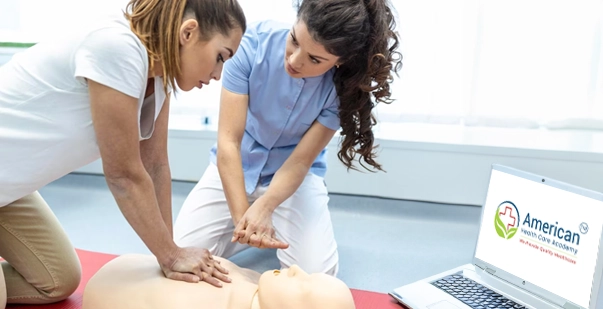Cardiopulmonary resuscitation (CPR) is available through online and local training. It is an individual’s choice whether you want to opt for online life-saving courses due to their busy schedules or local CPR course as it may be what one simply prefers. Both are effective methods but offer unique characteristics. Let us assess online CPR certification vs. in person training, also called local CPR training as we highlight their differences.
What is online CPR training?
Online CPR training is a form of certification that involves online learning. The method involves learning through videos and online quizzes. Along with videos, they also include study materials that explain the correct way to perform CPR.
What are the benefits of online CPR training?
Online CPR training is a popular form of learning owing to its benefits. The benefits involve the following:
- Learn at your own pace: Online CPR certification is self-paced. This ensures that participants can learn the course in their own time.
- Convenience: Online CPR certification is convenient and enables participants to study on the go. All you need is good internet connectivity, and a device so you can learn the course from anywhere.
- Cost: An online course is cheaper as compared to local CPR classes. It is easy on the pocket and highly beneficial for a student.
- Flexibility: If you are a student or have a full-time job, it can be difficult for you to attend the in person courses. Online classes provide flexibility and ensure that you can attend the course as per your schedule.
- Digital certification: On completion of the course, you will have the opportunity to take multiple-choice exams and receive CPR certification. Once you have passed the test, the CPR card is available for download.
Read More: https://cpraedcourse.com/blog/4-frequently-asked-questions-on-google-about-online-cpr-certification/
What is local CPR training?
Local CPR training or traditional in-person classes refers to hands-on courses delivered by qualified instructors. The participants attend the course in person and acquire knowledge. In this method, local instructors offer CPR learning.
What are the benefits of local CPR training?
Local CPR classes are practical-based learning and involve in person training. Instructors offer local CPR classes, which entail practical-based learning of CPR skills. This boosts the confidence of learners and enables them to perform CPR confidently.
Here are the benefits of local CPR training:
- Hands-on Learning: The technique offers hands-on learning and in person training.
- Immediate Feedback: Local training enables participants to learn from their mistakes and work on them. The training offers instant feedback and rectification.
- Boosts Confidence: Physical practice enhances your confidence and equips people to prepare for medical emergencies.
- It helps individuals connect: This enables participants to connect with like-minded professionals. This develops contacts and creates several future working relationships.
- Increase community readiness: CPR-trained residents make them prepared and enable them to handle crises effectively. This ensures the safety of community members.
How does the certification process vary between online and local CPR training?
The certification procedure for both CPR training online vs in person has the same ultimate objective: to equip people with the skills to carry out CPR successfully. However, the two approaches have very different procedures for obtaining this certification.
Online CPR training offers convenience and flexibility. With an internet connection, people may learn wherever they are and at their own pace. The procedure usually includes finishing an online course with video lessons, tests, and a final exam. Participants will acquire a CPR card immediately upon passing the course. On the other hand, local CPR training needs participants to show up in person.
Online vs. In Person CPR: Which one should you choose?
Your final decision about online CPR vs. classroom CPR training rests upon your needs and circumstances. If you are a student or have a job, you need flexibility. This is when online CPR training will be ideal. However, if you want hands-on learning, local CPR training will be beneficial. Local training is much more expensive. If you need affordable training, online CPR is your ideal choice. Additionally, once you complete the course, you must renew it every two years.
Conclusion
If you do not have time and need flexibility, opt for online CPR training. It will offer you the convenience of learning as per your needs. Local CPR training offers practical learning and is ideal for individuals wanting in person training. Assess your requirements and make the final decision between online vs. in person CPR. Enroll in a life-saving course to ensure you can be a life-saver whenever an emergency arises.









